#critics of fairytales
Explore tagged Tumblr posts
Text
A class on fairy tales (1)
As you might know (since I have been telling it for quite some times), I had a class at university which was about fairy tales, their history and evolution. But from a literary point of view - I am doing literary studies at university, it was a class of “Literature and Human sciences”, and this year’s topic was fairy tales, or rather “contes” as we call them in France. It was twelve seances, and I decided, why not share the things I learned and noted down here? (The titles of the different parts of this post are actually from me. The original notes are just a non-stop stream, so I broke them down for an easier read)
I) Book lists
The class relied on a main corpus which consisted of the various fairytales we studied - texts published up to the “first modernity” and through which the literary genre of the fairytale established itself. In chronological order they were: The Metamorphoses of Apuleius, Lo cunto de li cunti by Giambattista Basile, Le Piacevoli Notti by Giovan Francesco Straparola, the various fairytales of Charles Perrault, the fairytales of Marie-Catherine d’Aulnoy, and finally the Kinder-und Hausmärchen of Jacob and Wilhelm Grimm. There is also a minor mention for the fables of Faerno, not because they played an important historical role like the others, but due to them being used in comparison to Perrault’s fairytales ; there is also a mention of the fairytales of Leprince de Beaumont if I remember well.
After giving us this main corpus, we were given a second bibliography containing the most famous and the most noteworthy theorical tools when it came to fairytales - the key books that served to theorize the genre itself. The teacher who did this class deliberatly gave us a “mixed list”, with works that went in completely opposite directions when it came to fairytale, to better undersant the various differences among “fairytale critics” - said differences making all the vitality of the genre of the fairytale, and of the thoughts on fairytales. Fairytales are a very complex matter.
For example, to list the English-written works we were given, you find, in chronological order: Bruno Bettelheim’s The Uses of Enchantment ; Jack David Zipes’ Fairy Tales and the Art of Subversion ; Robert Bly’s Iron John: A Book about Men ; Marie-Louise von Franz, Interpretation of Fairy Tales ; Lewis C. Seifert, Fairy Tales, Sexuality and Gender in France (1670-1715) ; and Cristina Bacchilega’s Postmodern Fairy Tales: Gender and Narrative Strategies. If you know the French language, there are two books here: Jacques Barchilon’s Le conte merveilleux français de 1690 à 1790 ; and Jean-Michel Adam and Ute Heidmann’s Textualité et intertextualité des contes. We were also given quite a few German works, such as Märchenforschung und Tiefenpsychologie by Wilhelm Laiblin, Nachwort zu Deutsche Volksmärchen von arm und reich, by Waltraud Woeller ; or Märchen, Träume, Schicksale by Otto Graf Wittgenstein. And of course, the bibliography did not forget the most famous theory-tools for fairytales: Vladimir Propp’s Morfologija skazki + Poetika, Vremennik Otdela Slovesnykh Iskusstv ; as well as the famous Classification of Aarne Anti, Stith Thompson and Hans-Jörg Uther (the Aarne-Thompson-Uther Classification, aka the ATU).
By compiling these works together, one will be able to identify the two main “families” that are rivals, if not enemies, in the world of the fairytale criticism. Today it is considered that, roughly, if we simplify things, there are two families of scholars who work and study the fairy tales. One family take back the thesis and the theories of folklorists - they follow the path of those who, starting in the 19th century, put forward the hypothesis that a “folklore” existed, that is to say a “poetry of the people”, an oral and popular literature. On the other side, you have those that consider that fairytales are inscribed in the history of literature, and that like other objects of literature (be it oral or written), they have intertextual relationships with other texts and other forms of stories. So they hold that fairytales are not “pure, spontaneous emanations”. (And given this is a literary class, given by a literary teacher, to literary students, the teacher did admit their bias for the “literary family” and this was the main focus of the class).
Which notably led us to a third bibliography, this time collecting works that massively changed or influenced the fairytale critics - but this time books that exclusively focused on the works of Perrault and Grimm, and here again we find the same divide folklore VS textuality and intertextuality. It is Marc Soriano’s Les contes de Perrault: culture savante et traditions populaires, it is Ernest Tonnelat’s Les Contes des frères Grimm: étude sur la composition et le style du recueil des Kinder-und-Hausmärchen ; it is Jérémie Benoit’s Les Origines mythologiques des contes de Grimm ; it is Wilhelm Solms’ Die Moral von Grimms Märchen ; it is Dominqiue Leborgne-Peyrache’s Vies et métamorphoses des contes de Grimm ; it is Jens E. Sennewald’ Das Buch, das wir sind: zur Poetik der Kinder und-Hausmärchen ; it is Heinz Rölleke’s Die Märchen der Brüder Grimm: eine Einführung. No English book this time, sorry.
II) The Germans were French, and the French Italians
The actual main topic of this class was to consider the “fairytale” in relationship to the notions of “intertextuality” and “rewrites”. Most notably there was an opening at the very end towards modern rewrites of fairytales, such as Angela Carter’s The Bloody Chamber, “Le petit chaperon vert” (Little Green Riding Hood) or “La princesse qui n’aimait pas les princes” (The princess who didn’t like princes). But the main subject of the class was to see how the “main corpus” of classic fairytales, the Perrault, the Grimm, the Basile and Straparola fairytales, were actually entirely created out of rewrites. Each text was rewriting, or taking back, or answering previous texts - the history of fairytales is one of constant rewrite and intertextuality.
For example, if we take the most major example, the fairytales of the brothers Grimm. What are the sources of the brothers? We could believe, like most people, that they merely collected their tale. This is what they called, especially in the last edition of their book: they claimed to have collected their tales in regions of Germany. It was the intention of the authors, it was their project, and since it was the will and desire of the author, it must be put first. When somebody does a critical edition of a text, one of the main concerns is to find the way the author intended their text to pass on to posterity. So yes, the brothers Grimm claimed that their tales came from the German countryside, and were manifestations of the German folklore.
But... in truth, if we look at the first editions of their book, if we look at the preface of their first editions, we discover very different indications, indications which were checked and studied by several critics, such as Ernest Tomelas. In truth, one of their biggest sources was... Charles Perrault. While today the concept of the “tales of the little peasant house, told by the fireside” is the most prevalent one, in their first edition the brothers Grimm explained that their sources for these tales were not actually old peasant women, far from it: they were ladies, of a certain social standing, they were young women, born of exiled French families (because they were Protestants, and thus after the revocation of the édit de Nantes in France which allowed a peaceful coexistance of Catholics and Protestants, they had to flee to a country more welcoming of their religion, aka Germany). They were young women of the upper society, girls of the nobility, they were educated, they were quite scholarly - in fact, they worked as tutors/teachers and governess/nursemaids for German children. For children of the German nobility to be exact. And these young French women kept alive the memory of the French literature of the previous century - which included the fairytales of Perrault.
So, through these women born of the French emigration, one of the main sources of the Grimm turns out to be Perrault. And in a similar way, Perrault’s fairytales actually have roots and intertextuality with older tales, Italian fairytales. And from these Italian fairytales we can come back to roots into Antiquity itself - we are talking Apuleius, and Virgil before him, and Homer before him, this whole classical, Latin-Greek literature. This entire genealogy has been forgotten for a long time due to the enormous surge, the enormous hype, the enormous fascination for the study of folklore at the end of the 19th century and throughout all of the 20th.
We talk of “types of fairytales”, if we talk of Vladimir Propp, if we talk of Aarne Thompson, we are speaking of the “morphology of fairytales”, a name which comes from the Russian theorician that is Propp. Most people place the beginning of the “structuralism” movement in the 70s, because it is in 1970 that the works of Propp became well-known in France, but again there is a big discrepancy between what people think and what actually is. It is true that starting with the 70s there was a massive wave, during which Germans, Italians and English scholars worked on Propp’s books, but Propp had written his studies much earlier than that, at the beginning of the 20th century. The first edition of his Morphology of fairytales was released in 1928. While it was reprinted and rewriten several times in Russia, it would have to wait for roughly fifty years before actually reaching Western Europe, where it would become the fundamental block of the “structuralist grammar”. This is quite interesting because... when France (and Western Europe as a whole) adopted structuralism, when they started to read fairytales under a morphological and structuralist angle, they had the feeling and belief, they were convinced that they were doing a “modern” criticism of fairytales, a “new” criticism. But in truth... they were just repeating old theories and conceptions, snatched away from the original socio-historical context in which Propp had created them - aka the Soviet Union and a communist regime. People often forget too quickly that contextualizing the texts isn’t only good for the studied works, we must also contextualize the works of critics and the analysis of scholars. Criticism has its own history, and so unlike the common belief, Propp’s Morphology of fairytales isn’t a text of structuralist theoricians from the 70s. It was a text of the Soviet Union, during the Interwar Period.
So the two main questions of this class are. 1) We will do a double exploration to understand the intertextual relationships between fairytales. And 2) We will wonder about the definition of a “fairytale” (or rather of a “conte” as it is called in French) - if the fairytale is indeed a literary genre, then it must have a definition, key elements. And from this poetical point of view, other questions come forward: how does one analyze a fairytale? What does a fairytale mean?
III) Feuding families
Before going further, we will pause to return to a subject talked about above: the great debate among scholars and critics that lasted for decades now, forming the two branches of the fairytale study. One is the “folklorist” branch, the one that most people actually know without realizing it. When one works on fairytale, one does folklorism without knowing it, because we got used to the idea that fairytale are oral products, popular products, that are present everywhere on Earth, we are used to the concept of the universality of motives and structures of fairytales. In the “folklorist” school of thought, there is an universalism, and not only are fairytales present everywhere, but one can identify a common core for them. It can be a categorization of characters, it can be narrative functions, it can be roles in a story, but there is always a structure or a core. As a result, the work of critics who follow this branch is to collect the greatest number of “versions” of a same tale they can find, and compare them to find the smallest common denominator. From this, they will create or reconstruct the “core fairytale”, the “type” or the “source” from which the various variations come from.
Before jumping onto the other family, we will take a brief time to look at the history of the “folklorist branch” of the critic. (Though, to summarize the main differences, the other family of critics basically claims that we do not actually know the origin of these stories, but what we know are rather the texts of these stories, the written archives or the oral records).
So the first family here (that is called “folklorist” for the sake of simplicity, but it is not an official or true appelation) had been extremely influenced by the works of a famous and talented scholar of the early 20th century: Aarne Antti, a scholar of Elsinki who collected a large number of fairytales and produced out of them a classification, a typology based on this theory that there is an “original fairytale type” that existed at the beginning, and from which variants appeared. His work was then continued by two other scholars: Stith Thompson, and Hans-Jörg Uther. This continuation gave birth to the “Aarne-Thompson” classification, a classification and bibliography of folkloric fairytales from around the world, which is very often used in journals and articles studying fairytales. Through them, the idea of “types” of fairytales and “variants” imposed itself in people’s minds, where each tale corresponds to a numbered category, depending on the subjects treated and the ways the story unfolds (for example an entire category of tale collects the “animal-husbands”. This classification imposed itself on the Western way of thinking at the end of the first third of the 20th century.
The next step in the history of this type of fairytale study was Vladimir Propp. With his Morphology of fairytales, we find the same theory, the same principle of classification: one must collect the fairytales from all around the world, and compare them to find the common denominator. Propp thought Aarne-Thompson’s work was interesting, but he did complain about the way their criteria mixed heterogenous elements, or how the duo doubled criterias that could be unified into one. Propp noted that, by the Aarne-Thompson system, a same tale could have two different numbers - he concluded that one shouldn’t classify tales by their subject or motif. He claimed that dividing the fairytales by “types” was actually impossible, that this whole theory was more of a fiction than an actual reality. So, he proposed an alternate way of doing things, by not relying on the motifs of fairytales: Propp rather relied on their structure. Propp doesn’t deny the existence of fairytales, he doesn’t put in question the categorization of fairytales, or the universality of fairytales, on all that he joins Aarne-Thompson. But what he does is change the typology, basing it on “functions”: for him, the constituve parts of fairytales are “functions”, which exist in limited numbers and follow each other per determined orders (even if they are not all “activated”). He identified 31 functions, that can be grouped into three groups forming the canonical schema of the fairytale according to Propp. These three groups are an initial situation with seven functions, followed by a first sequence going from the misdeed (a bad action, a misfortune, a lack) to its reparation, and finally there is a second sequence which goes from the return of the hero to its reward. From these seven “preparatory functions”, forming the initial situation, Propp identified seven character profiles, defined by their functions in the narrative and not by their unique characteristics. These seven profiles are the Aggressor (the villain), the Donor (or provider), the Auxiliary (or adjuvant), the Princess, the Princess’ Father, the Mandator, the Hero, and the False Hero. This system will be taken back and turned into a system by Greimas, with the notion of “actants”: Greimas will create three divisions, between the subject and the object, between the giver and the gifted, and between the adjuvant and the opposant.
With his work, Vladimir Propp had identified the “structure of the tale”, according to his own work, hence the name of the movement that Propp inspired: structuralism. A structure and a morphology - but Propp did mention in his texts that said morphology could only be applied to fairytales taken from the folklore (that is to say, fairytales collected through oral means), and did not work at all for literary fairytales (such as those of Perrault). And indeed, while this method of study is interesting for folkloric fairytales, it becomes disappointing with literary fairytales - and it works even less for novels. Because, trying to find the smallest denominator between works is actually the opposite of literary criticism, where what is interesting is the difference between various authors. It is interesting to note what is common, indeed, but it is even more interesting to note the singularities and differences. Anyway, the apparition of the structuralist study of fairytales caused a true schism among the field of literary critics, between those that believe all tales must be treated on a same way, with the same tools (such as those of Propp), and those that are not satisfied with this “universalisation” that places everything on the same level.
This second branch is the second family we will be talking about: those that are more interested by the singularity of each tale, than by their common denominators and shared structures. This second branch of analysis is mostly illustrated today by the works of Ute Heidmann, a German/Swiss researcher who published alongside Jean Michel Adam (a specialist of linguistic, stylistic and speech-analysis) a fundamental work in French: Textualité et intertextualité des contes: Perrault, Apulée, La Fontaine, Lhéritier... (Textuality and intertextuality of fairytales). A lot of this class was inspired by Heidmann and Adam’s work, which was released in 2010. Now, this book is actually surrounded by various articles posted before and after, and Ute Heidmann also directed a collective about the intertextuality of the brothers Grimm fairytales. Heidmann did not invent on her own the theories of textuality and intertextuality - she relies on older researches, such as those of the Ernest Tonnelat, who in 1912 published a study of the brothers Grimm fairytales focusing on the first edition of their book and its preface. This was where the Grimm named the sources of their fairytales: girls of the upper class, not at all small peasants, descendants of the protestant (huguenots) noblemen of France who fled to Germany. Tonnelat managed to reconstruct, through these sources, the various element that the Grimm took from Perrault’s fairytales. This work actually weakened the folklorist school of thought, because for the “folklorist critics”, when a similarity is noted between two fairytales, it is a proof of “an universal fairytale type”, an original fairytale that must be reconstructed. But what Tonnelat and other “intertextuality critics” pushed forward was rather the idea that “If the story of the Grimm is similar but not identical to the one of Perrault, it is because they heard a modified version of Perrault’s tale, a version modified either by the Grimms or by the woman that told them the tale, who tried to make the story more or less horrible depending on the situation”. This all fragilized the idea of an “original, source-fairytale”, and encouraged other researchers to dig this way.
For example, the case was taken up by Heinz Rölleke, in 1985: he systematized the study of the sources of the Grimm, especially the sources that tied them to the fairytales of Perrault. Now, all the works of this branch of critics does not try to deny or reject the existence of fairytales all over the world. And it does not forget that all over the world, human people are similar and have the same preoccupations (life, love, death, war, peace). So, of course, there is an universality of the themes, of the motives, of the intentions of the texts. Because they are human texts, so there is an universality of human fiction. But there is here the rejection of a topic, a theory, a question that can actually become VERY dangerous. (For example, in post World War II Germany, all researches about fairytales were forbidden, because during their reign the Nazis had turned the fairytales the Grimm into an abject ideological tool). This other family, vein, branch of critics, rather focuses on the specificity of each writing style, of each rewrite of a fairytale, but also on the various receptions and interpretations of fairytales depending on the context of their writing and the context of their reading. So the idea behind this “intertextuality study” is to study the fairytales like the rest of literature, be it oral or written, and to analyze them with the same philological tools used by history studies, by sociology study, by speech analysis and narrative analysis - all of that to understand what were the conditions of creation, of publication, of reading and spreading of these tales, and how they impacted culture.
#fairy tales#fairytales#fairytale#fairy tale#a class on fairytales#brothers grimm#grimm fairytales#charles perrault#perrault fairytales#history of fairytales#vladimir propp#aarne-thompson classification#aarne-thompson#analysis of fairytales#critics of fairytales#book reference#sources#fairytale research#literary vs folklorist#which actually should be more intertextuality vs folklorist
107 notes
·
View notes
Text
I never for a moment interpreted the ending where Solas and Lavellan journey off into the Fade together as anything but hopeful.
The Inquisitor has been the Hero Who Saved the World for the last decade, and now she’s continuing that work. She’s not abandoning her duty. She’s venturing into the realm of pure magic to heal the Blight. Solas being there is just an enjoyable side benefit. Why can’t she save the day, get married to her true love, then head off on her next adventure? Heroes do those things all the time.
The game also is incredibly vague—and sure it’s implied they are going to the Fade Prison, which is the Black City—and Solas says it’ll be terrible… but he’s Mr. Grim and Fatalistic. Don’t listen to him. Lavellan responds that it won’t be terrible. It’s the Fade. You can shape it. It’s like the land of lucid dreaming. It will literally not be terrible if they are together. They’ll heal the Blight and help the Titans and go on many weird Fade adventures.
Again. It’s the Fade! It’s like the best sandbox for creating what comes next for them. They could totally spend all the time they’d like exploring Fade World, then return to the real world and find out only like… an afternoon has passed. Or I’m sure Dorian—after giving them a respectful amount of time for their Honeymoon—uses that magic knife to cut his way in and bring Lavellan an eluvian to use to visit him and her other friends and family whenever she wants. It’s not like they’re trapped forever. It’s left very open-ended. Have a little whimsy! Believe in true love that lasts forever and does not wane no matter the years that pass! Let them have a happily ever after. Why not. It’s fun.
#I see the most uncharitable solavellan ending takes floating about#and part of me gets it because if you don’t like him/them why would you imagine something nice or hopeful for them#but like that’s just your headcanon man#it’s not supported by the text#the text gives us next to nothing!#which is a criticism for sure#but come on have fun with it#They are star crossed lovers duty has torn apart#this is not real life#this is not about your divorce#this is a fairytale#he never stopped loving her#she never stopped loving him#space or time could not come between them now#yes it’s unrealistic but this is fantasy#let it be fantasy#Let it be happy#they’ve defeated the doomed by the narrative allegations
331 notes
·
View notes
Text
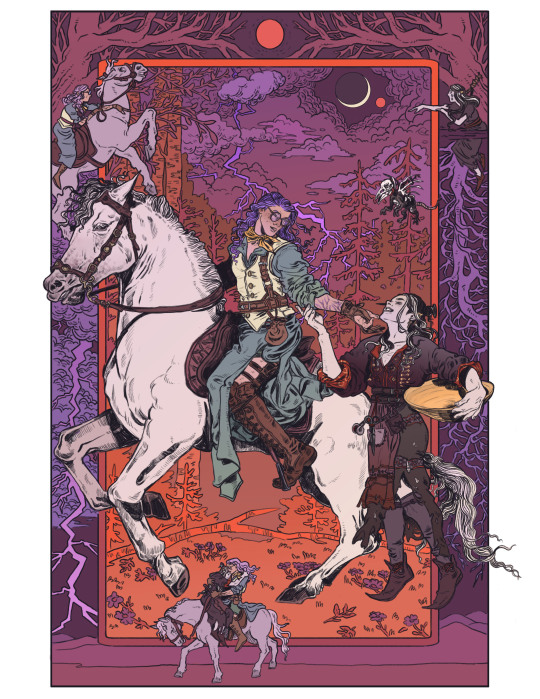
"She is neither pink nor pale, and she never will be all mine; she learned her hands in a fairy-tale, and her mouth on a valentine."
#critical role fan art#imogen x laudna#imogen temult#laudna#bells hells#cr3#fairytale#sapphic#wlw#southern gothic#imodna
966 notes
·
View notes
Text
I just realized that the Once Upon a Crime Cinderella is the Anti-Stolas. (Warning for Spoilers just in case)
Stolas is a rich and powerful prince who is glorified and romanticized even when he neglects his daughter (Seeing Stars) and sexually coerces his "love interest" (Murder Family). Anyone who has a problem with him has to either apologize and switch to his way of thinking (I.E. Octavia, Blitzo) or be vilified (I.E. Striker, Stella).

Cinderella is a poor young woman forced to slave away who's vilified the second she kills a creep in self defense. Yeah she did also try to frame Margot but 1. Margot abused her for years and killed her pet pigeon and 2. I feel like if Cinderella got arrested her family should've gotten arrested too for making her slave away yet that never happens.

#Anti Once Upon a Crime#Once Upon a Crime critical#Once Upon a Crime criticism#Once Upon a Crime#Cinderella#Anti Stolas#Stolas Critical#Stolas Criticism#Anti Helluva Boss#helluva boss criticism#helluva boss critical#anti vivziepop#vivziepop critical#vivziepop criticism#fairytale#fairy tales#fairytales#fairy tale#Ouac spoilers#Once Upon a Crime Spoilers
68 notes
·
View notes
Text
I think one of the funniest ways BH could find out about imodna is if Pâté asks in front of everyone if he should start calling Imogen "stepmother"
#critical role#critical role spoilers#cr spoilers#cr lb#laudna#imogen temult#imodna#pate de rolo#they've always had an interesting dynamic#imogen didnt really like him at the beginning but she seemed to like him more after he came to life#but i think the implications of a stepmother is so funny#especially if laudna read a lot of fairytales growing up#but also it would be funny because i think imogen and laudna would immediately start denying that theyre married#and that would be the perfect moment for someome to say they thought imodna had been married the whole time#(preferrably FCG or Fearne)
246 notes
·
View notes
Text

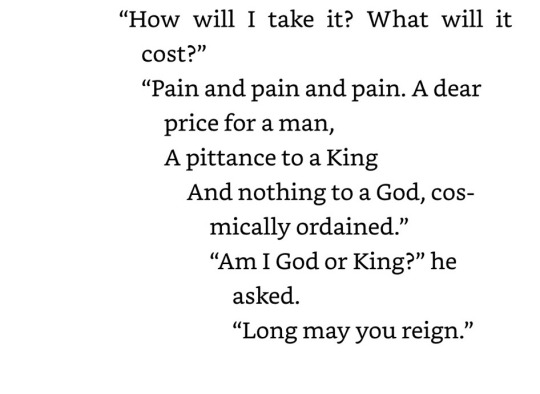

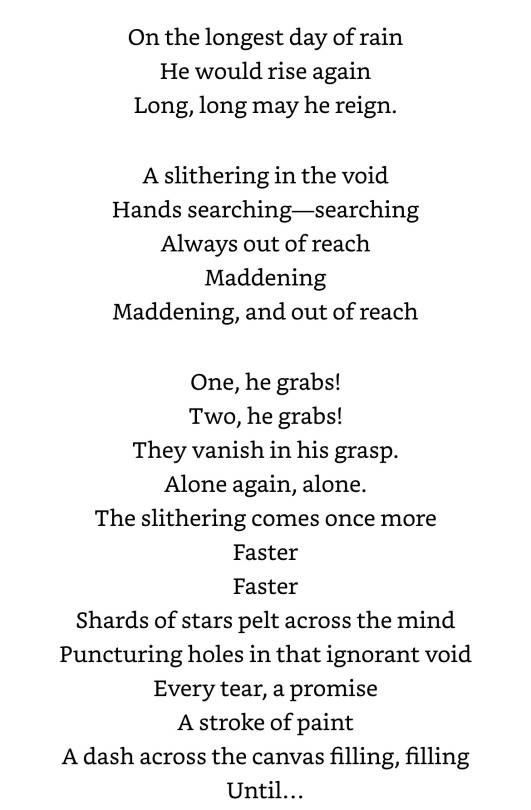

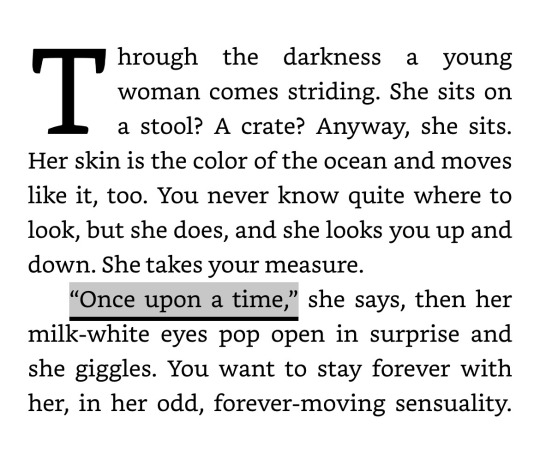
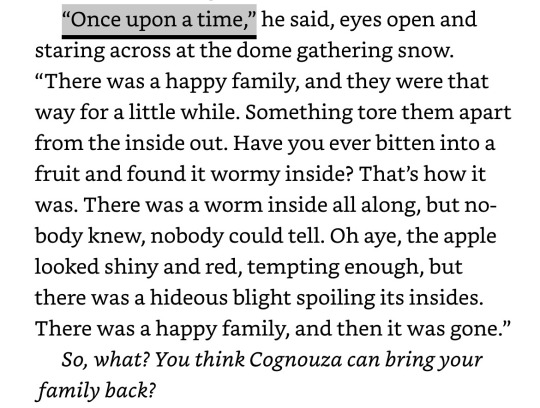

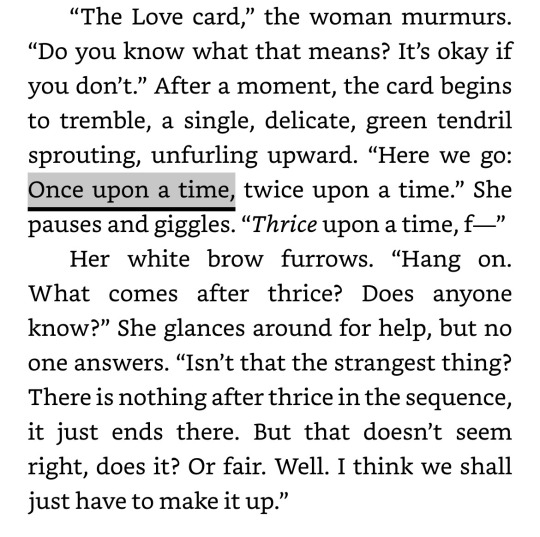
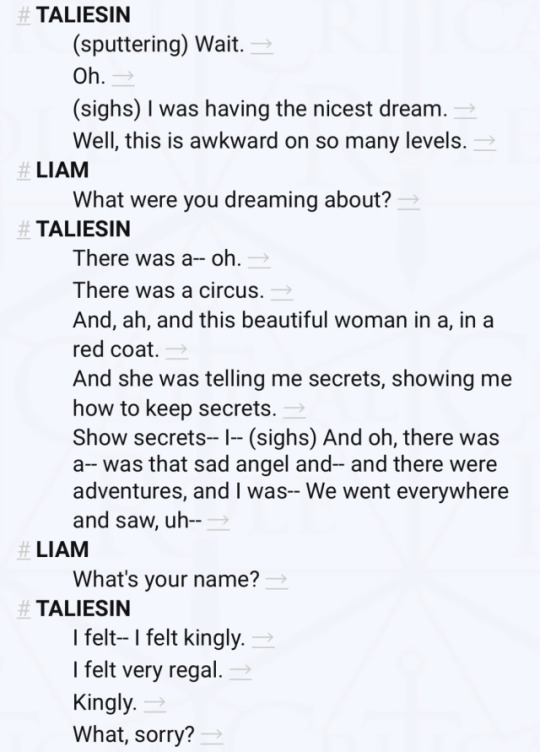
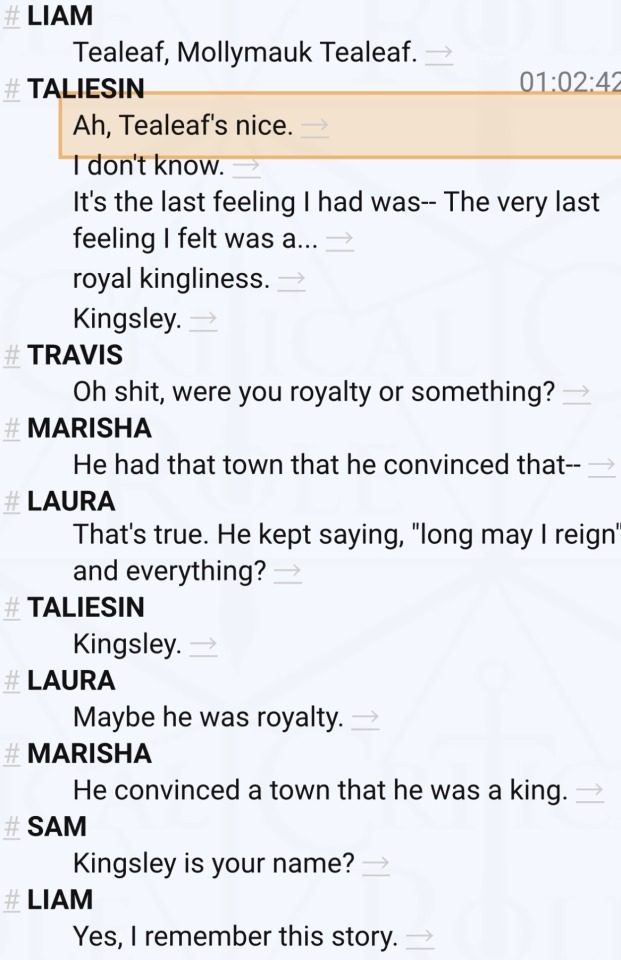

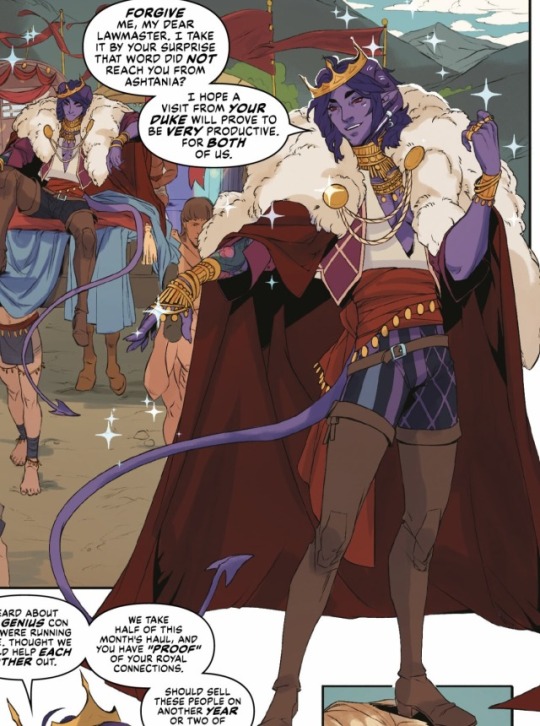
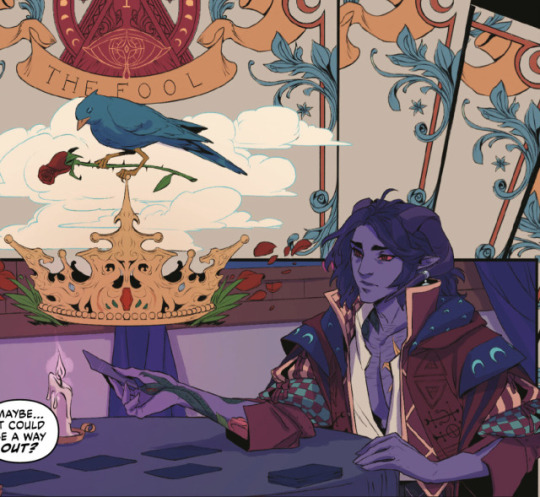

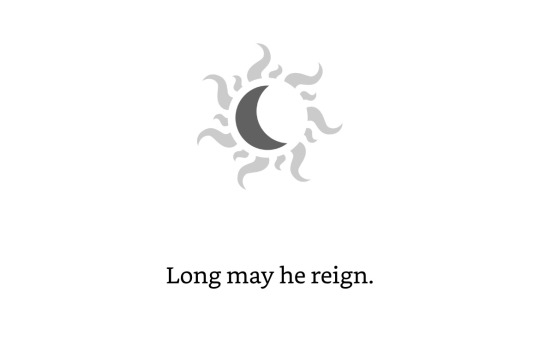
"I am your god, long may I reign." I'll never be over Mollymauk Tealeaf being fairytale royalty, the kind of happy life Lucien always dreamed of when he clung to childhood stories--"once upon a time," and the fantasy of a happy ending. The Moonweaver telling Molly a story from the place she calls home, singing a song of a King who was loved so much he came back from the dead. The way Molly latches onto that image even in another life, how he sees himself as royalty reincarnated. The Somnovem telling Lucien he is a king and a god--but one who is doomed to suffer terribly, still chained even in his dreams and even after death, never to be free. The Moonweaver spinning a tale where Molly is finally free, a king so beloved by his people, who will one day live and find happiness again. One day, one time, one life--he'll get his happy end. "Once upon a time, twice upon a time...thrice upon a time..."
#mollymauk tealeaf#kingsley tealeaf#lucien tavelle#yes literally being royalty right out of a fairytale still makes me weak#critical role#the romance of it all#love love love this little tief. long may he reign#also its especially cute to me that caleb and jester both loved fairytales so much. of course they both loved molly--
89 notes
·
View notes
Text
thinking about kid feeding the puppy and sita telling him not to “give her hope”
and then the rest of the film shows you that hope is the point. maybe it doesn’t immediately change things, or even save you entirely. but hope keeps you going.
hope is what it’s all for, no matter if, when , or how it ends
#monkey man#monkey man spoilers#watching the training sequence w the hijra#and realizing that this is the first time since he was a literal child that kid has had. people who cared about how he was doing#so *he* had a reason to care about how he was doing#pile that on top of the criticism of politics + organized religion + corruption#things that play on—the desire for community and hope and support. that end up making everyone lonelier than ever#i mean there’s like no way it’ll ever end with a fairytale happy ending. obviously. but the clarity? the purpose? the relief?#THAT’S HOPE BABY! that’s love! that’s connection! can’t even begin to stand up without it!
45 notes
·
View notes
Link
Chapters: 1/1 Fandom: Critical Role (Web Series) Rating: General Audiences Warnings: No Archive Warnings Apply Relationships: Ashton Greymoore & Orym Characters: Ashton Greymoore, Orym (Critical Role) Additional Tags: Alternate Universe - Fairy Tale Summary:
Orym goes searching for the creature that has been terrorizing his people. But perhaps monsters aren't always what they seem.
There was a monster in these mountains, Orym had been told. A creature of violence, of wickedness. A creature like the one that had taken Will from him. A creature that couldn't be reasoned with, couldn't be talked down, that had to be killed before it could destroy you.
There was a monster in these mountains and the monsters had already taken so many. They'd taken Annie's children, two years ago. Of course, she’d struggled to feed them even before that, even with what little help Orym and his mother and the other villagers were able to give, so maybe they were lucky the monsters had got there first.
There was a monster in these mountains and monsters ruined crops and stole livestock, flooded the river or dammed it up, and made it so hard for anyone to survive in the valley below. The king still took his tithe as usual, of course; someone had to fight against the monsters.
#critical role#ashton greymoore#orym of the air ashari#fairytale au#ashrym#ashrym week#cr fic#my fic
9 notes
·
View notes
Text
i think the Jedi-Positive and Jedi-Critical stances can be summed up on whether you value authorial intent or authorial execution.
Most of the Jedi-Positive people I follow quote George Lucas and director commentaries to prove their points, as well as utilize analyses from others at LucasFilm that have to keep the general status quo. It's all based on what Lucas was trying to portray, while ignoring the product in execution.
The Jedi-Critical stance tends to look at the prequel execution, and they question the obvious uncomfortable moments that have real-life parallels to atrocities. They tend to be more Legends fans, whose writers actually delved into the terrifying implications. It's all on criticizing execution while disregarding intent.
Like, take the argument about Jedi children. A Jedi-Positive person would argue that all the children are all given up with consent from their parents; this is what I am sure Lucas was intending to portray. A Jedi-Critical person will look at this and go "wait. how much 'consent' was in this encounter? the government can legally take these kids and have a representative show up to a farmer's house and tell the farmer they can technically say no? that is some bullshit." And there is real-life evidence for this. It's more on the execution.
Or the argument about love. Jedi-Positive people turn to Lucas's interview to show that they really meant it in the Buddhist sense, and if you value intent that works. Jedi-Critical people would argue that the marketing states that the Jedi cannot love, and nothing in the movies states that the Jedi meant non-toxic love when they eschew attachments.
They're both valid positions, but I think a lot of fandom brutality comes from not understanding either view, or demeaning one view in favor of another. It's perfectly acceptable to value one over the other.
#star wars#starwars#jedi#jedi order#the jedi order#star wars meta#sw fandom meta#sw#sw prequels#sw fandom#pro jedi#anti jedi#jedi critical#jedi positivity#I also think a lot of it is also based on filters as well#but i didn't want to crowd the post#lucas used a fairytale structure to write his story#but there's still a huge portion of deconstruction in canon stuff#maybe i'll write more
324 notes
·
View notes
Text
Critics who treat 'adult' as a term of approval, instead of as a merely descriptive term, cannot be adult themselves. To be concerned about being grown up, to admire the grown up because it is grown up, to blush at the suspicion of being childish; these things are the marks of childhood and adolescence. And in childhood and adolescence they are, in moderation, healthy symptoms. Young things ought to want to grow. But to carry on into middle life or even into early manhood this concern about being adult is a mark of really arrested development. When I was ten, I read fairy tales in secret and would have been ashamed if I had been found doing so. Now that I am fifty I read them openly. When I became a man I put away childish things, including the fear of childishness and the desire to be very grown up.
- C.S. Lewis, Of Other Worlds: Essays and Stories
#c.s. lewis#quotes#literature#fantasy#fairytales#children's literature#words#have been thinking about this quote a lot lately#non fiction#essays#literary criticism#light academia
10 notes
·
View notes
Text
Ok, I understand what I meant when I said that magical hair shit didn’t add anything to the story. I wasn’t talking about tangled, I was talking about the Rapunzel fairy tale as a whole.
Rapunzel was my favorite fairy tale, and I watched or read every adaptation of the story. Every adaptation brought something new to this tale and stood out to me. Like Barbie as Rapunzel had her as a princess and another adaptation had Rapunzel be a robot. I thought Disney would have some kind of twist to add to the story with tangled, but they didn’t. I felt like they went with the most basic premise in tangled and didn’t really try anything new. But the more I thought about the new additions Disney added in tangled, the more I thought that it extremely unnecessary to the story of Rapunzel. Like the dumb addition of the magical hair and the witch wanting to be young as a motivation instead of keeping Rapunzel safe? Did we really need that sexist and ageist plot point put in? There are so many routes they could have gone with the witch, and they basically made her the evil queen from Snow White but bland. It also added even more antisemitic elements to the story when the “original” fairy tale is already antisemitic. From making gothel look like that to characterizing her as an antisemitic caricature. How did you make an adaptation of an old fairy tale even more offensive? I’m not saying that the “original” fairy tale is perfect. I'm saying that the writers on tangled fucked up big time when they had the resources to know better and avoid making a walking stereotype. So that’s what I meant when I said this plot point didn’t add anything to the story of Rapunzel. I hate this stupid “magic hair and evil witch wants to be young for no reason” plot point, and I’m so happy that it isn’t in any of the adaptations of Rapunzel nowadays.
Edit: a stupid ass tangled stan saw my issues with ageism, sexism and antisemitism in tangled and thought "how dare you! this is true to real life." fuck off, gothel is a fucking antisemitic caricature! So if you have any stupid ass statements like that, don’t interact with this post. Be a clown elsewhere.
58 notes
·
View notes
Text
I just think the fandom’s nastier responses to the bg3 men is wildly interesting
like. you have three men who are coming out of highly unhealthy relationships.
One of them gets super sexualized and infantilized at the exact same time. literally people put him in the bdsm harness while simultaneously misinterpreting elven cultural norms to say he’s mentally no more mature than a teenager despite having been a whole-ass local judge who died because he gave out corrupt rulings and got his ass jumped because of them.
the other gets treated like he’s an incel because he catches feelings quickly, despite being wildly respectful when you turn him down. Half the issues were due to a bug, the other is that this man is so starved for validation because his goddess - whom has paid special interest to him since he was a toddler - kept him constantly feeling lesser-than because despite calling him her Chosen, she gives him none of the power we see Chosens be given by other gods. Not to mention she sends her other ex - his mentor and friend - to tell him to off himself to earn her forgiveness. For some reason his attempts to gain god-like power are received worse than the borm-sexy-yesterday-vampire despite both of them having the goal of being safe from manipulation and control. I assume because the vampire gets a sex scene when you let him destroy his soul for power and the wizard does not.
The fairytale prince route, despite typically being very popular, is being called boring and dull and while, yes, he has less drama than some of the others, is still compelling and has high stakes for that character. He’s sold his soul but he thinks the price is worth it and he’s made his peace with the personal cost because he’s helping people. The only real difference between this character and others who are willing to sell their souls for the good of their lands is that this time around, he’s Black
#bg3#baldur’s gate 3#fandom critical#I guess?#like Wyll’s shit seems to genuinely be people are racist and not realizing or caring to realize#he’s a delight! he wants to dance with you! he’s a sweetheart going by the fairytale chivalric code#meanwhile he’s literally made a deal with a devil to make the princely thing happen#it’s good! he’s the vanilla ice cream route and it’s very lovely#literally his route is so similar to Alistair in the choices to give up your life for the world#I love astarion and he is in fact very sexy#and he likes sex when he has the final say in whether it’s happening#but that damn tombstone has some people acting creepy as fuck#yes it’s sad how young he was but he was also a whole adult man when he died#and Gale… you can argue very easily he was groomed#and even if he wasn’t - this man has isolated himself for a /year/ trying not to hurt anyone#yeah he’s gonna get attached to the first people he gets to hang with#he’s hurt when you turn him down but he’s not a dick#then he becomes your ride-or-die#he’s a sweetheart#Halsin has his own shit going but he seems to a companion solely because people thirsted so hard#but he’s also worked through his shit and is decently mentally stable#not letting ppl reblog this because I don’t need people acting a fool on my post
144 notes
·
View notes
Text
Wow, I thought it was gonna be the Ruby episode. It was not.
And wow, for a show that advocates "true love", this mini-plot sucks. Because dwarfs and fairies are just "supposed to do their jobs" and all that shite. Yeah, sacrifice your happiness to "bring joy to the world". Except if you're a main character type, then you can choose true love.
Not good, show. Not nice. You just wanted to justify why Grumpy is grumpy? And why you gotta hurt Nova like that? They both just want to be happy. There are LOTS of dwarves and fairies that are content with the status quo but you just HAD to break these two apart.
Also, are you telling me that after all this, Grumpy fell in love again and had that diamond fiasco which was why he got sent to jail (where he met Snow)? Seems like dwarves DO love. And seems like they (writers? Directors? Idk) forgot about that Grumpy backstory just a few eps ago.
Guess the show has pockets I didn't notice before.
#ouat#ouat rewatch#ouat s1e14#once upon a time#grumpy#dreamy#nova#weird brain stuff#am i being too dramatic and critical?#it just rubbed me the wrong way#like.they have a whole affair arc but god forbid a dwarf and a fairy fall in love#it just feels like it's sending the wrong message or am i the one reading it wrong#maybe this is why rumple hates fairies#or maybe i'm just not fairytale protagonist coded#or maybe it really doesn't make sense#and it doesn't have to#maybe.idk#halp
11 notes
·
View notes
Text
fearne: oh my god no they loved it
matt, smiling: yeah flowers can’t clap
#critical role#cr lb#ASHLEY SAID WE WANT A GUILLERMO DEL TORO FAIRYTALE AND MATT SAID I GOT YOU GIRL DO I GOT YOU
142 notes
·
View notes
Text
I'm bored and Viv is a shit writer so I'm gonna go into how the Helluva Boss Stolas is a fucked up version of Snow White:
Stolas's human form has pale white skin, black hair and red eyes/Snow White has pale white skin, black hair and red lips - Stolas is a horrible person while Snow White is not.
Stolas has an abusive father with a connection to mirrors/Snow White has an abusive mother or stepmother with a connection to mirrors - Stolas becomes just like his father while Snow White is better than her mother or stepmother.
Stolas is connected to a female antagonist concerned about her reputation/Snow White is connected to a female antagonist concerned about her reputation - Helluva Boss uses Stella to excuse Stolas's bad behavior while Little Snow White doesn't do that.
Stolas is a prince connected with shorter, lower class imps/Snow White is a princess connected with shorter, lower class dwarves - Stolas treats imps like absolute shit while Snow White befriends the seven dwarves.
Stolas could be said to be "awakened" by Blitzo in a sleep-like experience/Snow White was awakened by her Prince when the Queen poisoned her - Stolas goes on to sexually coerce his "lover" which Snow White never does.
Stolas wants Blitzo to be his knight in shining armor/Snow White's true love is a Prince - As said before Stolas sexually coerces and fetishizes Blitzo which Snow White never does.
Stolas has to deal with Striker trying to assassinate him under Stella's orders/Snow White has to deal with the Huntsman trying to assassinate her under the Queen's orders - Stolas treated the situation unseriously enough to where he was making sex jokes while Snow White was concerned for her life.
In conclusion Snow White is better lol.
#anti helluva boss#helluva boss criticism#helluva boss critical#anti stolas#stolas critical#stolas criticism#fairytale#fairy tale#fairy tales#fairytales#Snow White#Little Snow White
50 notes
·
View notes
Text
One thing that always annoys tf about me about the ‘Snow White should be white/pale’ posts is that you are literally buying into racist themes in fairytales…. Are you all five years old… can you try to use your brains for 0.01 seconds
#snow white live action is fucking shitty as well and hopefully bombs the box office#but my god are the haters some of the most annoying people ever#like maybe fairytales don’t exist in a vaccum and you should critically think about them#and are affected by the contexts in which thry were created and changed throughout the ages and through various reiterations
2 notes
·
View notes